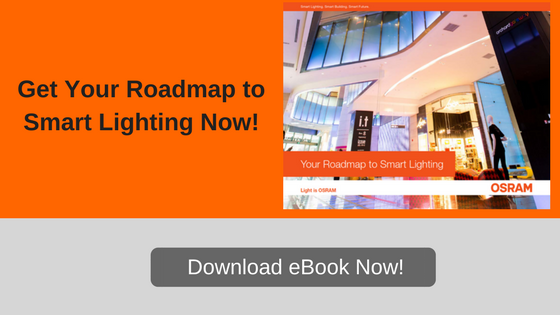Make Your Employees Productive and Happy: Go Green with Smart Lighting!
 We have highlighted the benefits of green building standards in previous blogs including The WELL Building Standard: The Future of Modern Design and Going Green with LEED. Now, a report from the World Green Building Council (WorldGBC) makes the business case for green buildings that contain health and wellbeing features such as enhanced fresh air ventilation, an increase of daylight penetration and the use of biophilic design elements. Findings cited in the report include reduced employee absenteeism, minimized operating costs and employees that felt more productive and healthier after these features were added.
We have highlighted the benefits of green building standards in previous blogs including The WELL Building Standard: The Future of Modern Design and Going Green with LEED. Now, a report from the World Green Building Council (WorldGBC) makes the business case for green buildings that contain health and wellbeing features such as enhanced fresh air ventilation, an increase of daylight penetration and the use of biophilic design elements. Findings cited in the report include reduced employee absenteeism, minimized operating costs and employees that felt more productive and healthier after these features were added.
Case Study Results
The report examines case studies of 11 facilities around the globe that have one or more green certifications including LEED, Green Star, and BREEAM. After adding health and wellbeing features into these green-certified buildings, based on pre- and post-occupancy surveys, companies realized tangible benefits including energy consumption reductions, improvements in occupant wellbeing, satisfaction and productivity, and strong financial returns.
Excerpts from the findings reported include:
- Green features for the American Society of Interior Designers’ (ASID) new HQ in Washington D.C.include indoor air quality, biophilia/views and lighting. A circadian lighting strategy was implemented based on occupant demographics, office location and the solar cycle. The move to the new building saw an increase in employee productivity and reduction of absenteeism, which is expected to pay for its investment within the first five years.
- The Akron Children’s Hospital project by HKS in Ohio integrated several green features including lighting, indoor air quality, and biophilia/views resulting in an average improved satisfaction level of 67% by patients, family and staff. Hospital staff cited lighting levels and air quality, in particular, as key features that supported their work. In addition, over US$900,000 in annual energy cost savings was achieved.
- Sherwin-William’s office refurbishment of their Centro-America headquarters in El Salvador features lighting, indoor air quality, acoustics and materials. The company saw a 68% reduction in reported respiratory problems and a 64% reduction in reported allergy problems. Company absenteeism reduced by 44% that the company calculated as a savings of US$85,000 per year.
- Green features at Landsec’s new UK workplace include lighting, indoor air quality and interior layout. A circadian lighting strategy was implemented as well as user-controlled lighting settings for specific tasks. After occupying the new space, over 90% of employees agree the new office design enable productive work and there is a 25% increase in satisfaction with lighting levels.
- Arup’s office fit-out in Boston features lighting, indoor air quality, interior layout and biophilia/views. Use of a circadian lighting strategy in particular contributed to reduced energy consumption and increased occupant satisfaction.
To learn more, read the complete WGBC report Doing Right by Planet and People: The Business Case for Health and Wellbeing in Green Building.
Smart Lighting Supports Green Buildings
Lighting plays a significant role in green building design. LED lighting and intelligent lighting controls offer a quick means of reducing a building’s energy usage and the related costs. An LED installation can save 40% or more as compared to traditional incandescent and fluorescent lighting. Even greater savings can be achieved using an automated control system that leverages occupancy sensors and other lighting control strategies.
Smart lighting using an intelligent lighting control system addresses the visual needs of the space by enabling the right amount of light at the right time based on occupancy, a timed event, daylight level, and more. Smart control strategies including daylight harvesting, personal control, occupancy sensing, time scheduling, task tuning and demand response offer a comprehensive approach to improving energy efficiency. When used in combination with each other, maximum energy savings is attainable.
Human Centric Lighting for Health and Wellbeing
Human Centric Lighting (HCL) is a strategy based on circadian rhythms, the body’s natural 24-hour clock that is synchronized with the Earth’s natural lighting cycle. HCL expands the scope of lighting design beyond the traditional architectural approach (aesthetics, visibility and safety) and incorporates a science-based approach (considering visual and non-visual effects of light). HCL can help improve occupant productivity levels as well as boost occupant health and wellness. To learn more about Human Centric Lighting, take a look at our blog post Human Centric Lighting in Commercial Offices Boosts Health, Well-being & Productivity.
A 2017 study from the Lighting Research Center (LRC) at Rensselaer Polytechnic Institute revealed that office workers who receive a robust dose of circadian-effective light experienced better sleep and lower levels of depression and stress, as compared to those who spent their days in dim or low light levels. Further research from LRC showed that lighting systems delivering a high amount of circadian-effective light, especially early in the workday, could reduce sleepiness in office workers while also improving their mood and alertness.
The research team found that even in open offices with many, large windows, office workers were not receiving enough light to stimulate their circadian system during the day, due to factors such as season, cloud cover, desk orientation, and window shade position.
Human Centric Lighting (HCL) aims to improve occupant productivity, health and wellness. And productive, healthy employees can improve the bottom line.
To learn more about smart lighting, download the ebook below.
Topics: Human Centric Lighting, Trends, Sustainability

.png)
